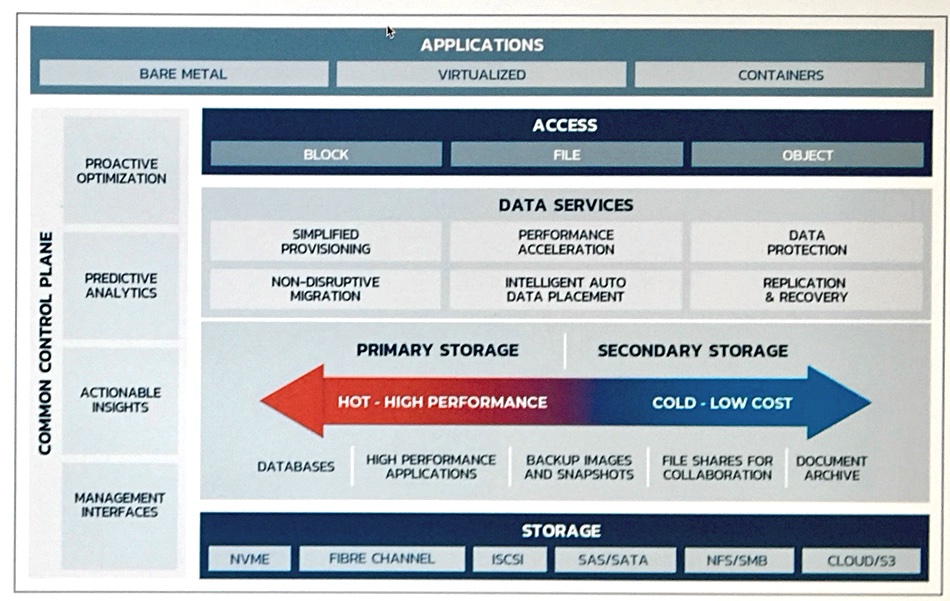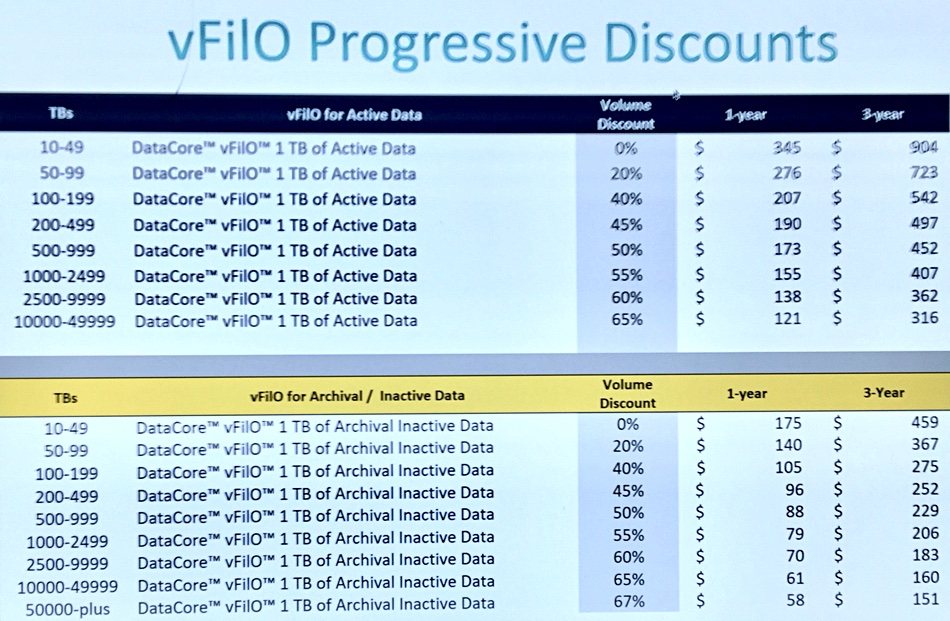DataCore has added file and object storage to its software-defined storage portfolio. vFiLO inherits block-oriented SANsymphony’s scale-out, tiering and parallel IO architecture, and the ability to virtualize third-party file and object stores.
vFiLO can be used alongside SANsymphony or independently. It supports NFS (v3, v4.2), SMB (v2, v3) and the S3 protocol inside a global namespace, and presents files or objects to users. Kubernetes CSI is also supported. There is a single flat metadata catalogue, as is typical with object storage, which covers files as well. The same data can be accessed as either a file or an object.
The vFiLO software image runs on Linux, either on a physical server or as a virtual machine, and forms a vFiLO data services node. These are clustered with a 40-node limit and high-availability support.
Up to 16 remote sites can access a vFiLO system making it usable for collaboration work, which would otherwise need separate file sync and share SW.

Data is tiered across SSDs and disk with the software taking care of data placement across a system’s fast and slow storage drives in a primary to secondary storage spectrum. DataCore says this placement is assisted by using system telemetry and machine learning models.
The control plane software directs accesses to drives using parallel NFS to speed IO.
As nodes are added or removed from the system the vFiLO software automatically carries out load-balancing to remove IO choke points and spread the work evenly across the system’s nodes.
File and object lifecycle management can be driven by policies relating to data’s age, size, IO history, requested resiliency and performance needs. Basically old and unused files and objects can be shuffled off to slower, cheaper, archival storage. That means either public cloud or on-premises object storage systems, with the data being deduped, compressed and encrypted.
If that data is then re-accessed it’s rehydrated and re-ingested. Data can be replicated and backed up (snapshotted) with policies driving the actions. Unintentionally deleted data can be recovered by users without involving admin staff.
Using third-party filers and object systems
Third-party file and object storage products that can be virtually ingested include Dell EMC Isilon, Unity and PowerMax, VMAX, NetApp 7-mode, C-mode and Cloud Volumes, SoftNAS Cloud, Google Cloud Filestore, other NFS systems, AWS and generic S3, Dell EMC ECS, Cloudian HyperStore, Azure and Google Cloud Storage.
Once added by admin staff their metadata is scanned and incorporated in the vFiLO metadata scheme. The third-party files and objects are then accessible by vFiLO users. Data can be physically ingested if required and such data migrations are non-disruptive and can be run with live data.
The metadata in a vFiLO system can be extended by users, with additional tags added for keyword search and ad-hoc correlations of files and objects. The SW offers natural language query facilities.
Pricing and availability
Product pricing is based on capacity consumed in terabytes, with one price for active data and a lower price for inactive archives. There is a 10TB minimum and 1TB granularity after that, with 1- and 3-year subscriptions, and volume discounts, as shown in the table;

There is no additional charge for data services node software and users can add nodes as they see fit.
The vFiLO SW will be generally available from November 20. The global namespace feature will be delivered in 2020. The 16 remote site support will come in the first half of 2020. Deduplication, compression and encryption services need third-party object storage.
Comment
The vFiLO software takes DataCore into competition with file and object storage suppliers, as well as file data lifecycle suppliers such as Cohesity (Smart Files), Data Dynamics (StorageX) Komprise, and Spectra Logic (StorCycle).
It’s collaboration feature pits it against Nasuni and Panzura, and its global namespace means it may meet Hammerspace in customer bids.
Actually not as, according to consultant Philippe Nicolas writing in the Storage Newsletter, DataCore is partnering with Hammerspace to use its technology.
However, a default market for vFiLO will lie in DataCore’s 10,000+ customer base, and that could keep DataCore’s channel partners busy for several years.








